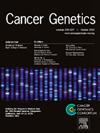53.分类难题:髓样肿瘤的归属?
IF 1.4
4区 医学
Q4 GENETICS & HEREDITY
引用次数: 0
摘要
急性髓性白血病(AML)和骨髓增生异常肿瘤(MDS)一直依赖世界卫生组织(WHO)系统进行分类。2022 年,两个独立的系统被提出来取代之前的世界卫生组织第四版(WHO4):世界卫生组织第五版(WHO5)和国际共识分类(ICC)系统。这两个系统都使用重复出现的基因变化、疾病生物学和临床特征对 AML 和 MDS 进行分类。为了比较WHO5和ICC,我们回顾了2016年至2022年期间在温哥华总医院确诊的具有细胞遗传学、测序和临床数据报告的AML和MDS病例。将每个系统应用于 446 例骨髓肿瘤病例后,我们定义了 90 例在 WHO5 和 ICC 之间存在差异的病例。在 ICC 中,有 28 个病例被定义为 TP53 突变的 AML,而 WHO5 中却没有相应的类别。ICC提出的MDS/AML类别适用于39例病例;根据WHO5,这些病例被定义为TP53双倍突变的MDS(MDS-biTP53)、囊泡增多的MDS(MDS-IB2)或纤维化的MDS(MDS-f)。在 ICC 下,4 例 RUNX1 基因突变的急性髓细胞性白血病和 4 例孤立的 8 三体综合征急性髓细胞性白血病在基因上被定义,而在 WHO5 下,这 8 例病例在基因上未被定义。根据 WHO5,2 例 MDS 升级为 NPM1 基因突变的急性髓细胞性白血病,但根据 ICC,这些病例不符合急性髓细胞性白血病的鼓室截断值。其余 10 例 MDS 存在术语差异,3 例 MDS 或 AML 处于特定基因标准的边缘。本文章由计算机程序翻译,如有差异,请以英文原文为准。
53. The classification conundrum: Where do myeloid neoplasms belong?
Acute myeloid leukemia (AML) and myelodysplastic neoplasms (MDS) have relied on the World Health Organization (WHO) system for classification. In 2022, two independent systems were proposed to replace the previous WHO fourth edition (WHO4): the WHO fifth edition (WHO5) and the International Consensus Classification (ICC) systems. Both use recurring genetic changes, disease biology and clinical features to categorize AML and MDS. To compare WHO5 and ICC, we reviewed cases of AML and MDS with reported cytogenetic, sequencing, and clinical data which were diagnosed at Vancouver General Hospital between 2016 and 2022. After applying each system to 446 total myeloid neoplasm cases, we defined 90 cases showing discrepancies between WHO5 and ICC. Under ICC, 28 cases are defined as AML with mutated TP53, while the corresponding category is absent in WHO5. The MDS/AML category put forth by ICC applies to 39 cases; these cases are defined as either MDS with biallelic TP53 mutations (MDS-biTP53), MDS with increased blasts (MDS-IB2), or MDS with fibrosis (MDS-f) under WHO5. Under ICC, 4 cases of AML with mutated RUNX1 and 4 cases of AML with isolated trisomy 8 are genetically defined, whereas these 8 cases are not genetically defined by WHO5. Under WHO5, 2 cases of MDS are upgraded to AML with mutated NPM1, but these cases do not meet the blast cut-off for AML according to ICC. Of the remaining, 10 cases of MDS have terminological differences, and 3 cases of MDS or AML are at the borderline of specific genetic criteria.
求助全文
通过发布文献求助,成功后即可免费获取论文全文。
去求助
来源期刊

Cancer Genetics
ONCOLOGY-GENETICS & HEREDITY
CiteScore
3.20
自引率
5.30%
发文量
167
审稿时长
27 days
期刊介绍:
The aim of Cancer Genetics is to publish high quality scientific papers on the cellular, genetic and molecular aspects of cancer, including cancer predisposition and clinical diagnostic applications. Specific areas of interest include descriptions of new chromosomal, molecular or epigenetic alterations in benign and malignant diseases; novel laboratory approaches for identification and characterization of chromosomal rearrangements or genomic alterations in cancer cells; correlation of genetic changes with pathology and clinical presentation; and the molecular genetics of cancer predisposition. To reach a basic science and clinical multidisciplinary audience, we welcome original full-length articles, reviews, meeting summaries, brief reports, and letters to the editor.
 求助内容:
求助内容: 应助结果提醒方式:
应助结果提醒方式:


